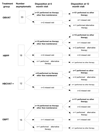Long-term effectiveness of treatments for symptomatic convergence insufficiency in children
- PMID: 19668097
- PMCID: PMC2780441
- DOI: 10.1097/OPX.0b013e3181b6210f
Long-term effectiveness of treatments for symptomatic convergence insufficiency in children
Abstract
Purpose: To assess the long-term stability of improvements in symptoms and signs in 9- to 17-year-old children enrolled in the Convergence Insufficiency Treatment Trial who were asymptomatic after treatment for convergence insufficiency.
Methods: Seventy-nine patients who were asymptomatic after a 12-week therapy program for convergence insufficiency were followed for 1 year [33/60 in office-based vergence/accommodative therapy (OBVAT), 18/54 in home-based pencil push-ups (HBPP), 12/57 in home-based computer vergence/accommodative therapy and pencil push-ups (HBCVAT+), and 16/54 in office-based placebo therapy (OBPT)]. Symptoms and clinical signs were measured 6 months and 1 year after completion of the 12-week therapy program. The primary outcome measure was the mean change on the Convergence Insufficiency Symptom Survey (CISS). Secondary outcome measures were near point of convergence, positive fusional vergence at near, and proportions of patients who remained asymptomatic or who were classified as successful or improved based on a composite measure of CISS, near point of convergence, and positive fusional vergence.
Results: One-year follow-up visit completion rate was 89% with no significant differences between groups (p = 0.26). There were no significant changes in the CISS in any treatment group during the 1-year follow-up. The percentage who remained asymptomatic in each group was 84.4% (27/32) for OBVAT, 66.7% (10/15) for HBPP, 80% (8/10) for HBCVAT+, and 76.9% (10/13) for OBPT. The percentage who remained either successful or improved 1-year posttreatment was 87.5% (28/32) for OBVAT, 66.6% (10/15) for HBPP, 80% (8/10) for HBCVAT+, and 69.3% (9/13) for OBPT.
Conclusions: Most children aged 9 to 17 years who were asymptomatic after a 12-week treatment program of OBVAT for convergence insufficiency maintained their improvements in symptoms and signs for at least 1 year after discontinuing treatment. Although the sample sizes for the home-based and placebo groups were small, our data suggest that a similar outcome can be expected for children who were asymptomatic after treatment with HBPP or HBCVAT+.
Trial registration: ClinicalTrials.gov NCT00338611.
Figures
References
-
- Scheiman M, Mitchell GL, Cotter S, Cooper J, Kulp M, Rouse M, Borsting E, London R, Wensveen J. A randomized clinical trial of treatments for convergence insufficiency in children. Arch Ophthalmol. 2005;123:14–24. - PubMed
-
- Wick B. Vision training for presbyopic nonstrabismic patients. Am J Optom Physiol Opt. 1977;54:244–247. - PubMed
-
- Patano FM. Orthoptic treatment of convergence insufficiency: a two year follow-up report. Am Orthop J. 1982;32:73–80.
-
- Cohen AH, Soden R. Effectiveness of visual therapy for convergence insufficiencies for an adult population. J Am Optom Assoc. 1984;55:491–494. - PubMed
Publication types
MeSH terms
Associated data
Grants and funding
LinkOut - more resources
Full Text Sources
Medical


